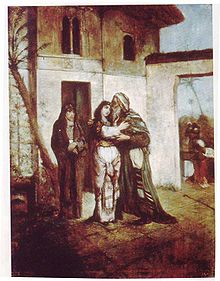- Nathan the Wise
-
 Recha Welcoming Her Father, 1877 illustration by Maurycy Gottlieb
Recha Welcoming Her Father, 1877 illustration by Maurycy Gottlieb
Nathan the Wise (original German title: Nathan der Weise) is a play by Gotthold Ephraim Lessing, published in 1779. It is a fervent plea for religious tolerance. Its performance was forbidden by the church during Lessing's lifetime.
Set in Jerusalem during the Third Crusade, it describes how the wise Jewish merchant Nathan, the enlightened sultan Saladin and the (initially anonymous) Templar bridge their gaps between Judaism, Islam and Christianity. Its major themes are friendship, tolerance, relativism of God, a rejection of miracles and a need for communication.
Contents
Ring Parable
The centerpiece of the work is the Ring Parable (German: Ringparabel), narrated by Nathan when asked by Saladin which religion is true: An heirloom ring with the magical ability to render its owner pleasant in the eyes of God and mankind had been passed from father to the son he loved most. When it came to a father of three sons whom he loved equally, he promised it (in "pious weakness") to each of them. Looking for a way to keep his promise, he had two replicas made, which were indistinguishable from the original, and gave on his deathbed a ring to each of them.
The brothers quarrelled over who owned the real ring. A wise judge admonished them that it was impossible to tell at that time – that it even could not be discounted that all three rings were replicas, the original one having been lost at some point in the past; that to find out whether one of them had the real ring it was up to them to live in such a way that their ring's powers could prove true, to live a life that is pleasant in the eyes of God and mankind rather than expecting the ring's miraculous powers to do so. Nathan compares this to religion, saying that each of us lives by the religion we have learned from those we respect.
Background
The character of Nathan is to a large part modeled after Lessing's lifelong friend, the eminent philosopher Moses Mendelssohn. Similar to Nathan the Wise and Saladin, whom Lessing makes meet over the chess-board; they both shared a love for the game.[1]
The motif of the Ring Parable is derived from a complex of medieval tales which first appeared in the German language in the story of Saladin's table in the Weltchronik of Jans der Enikel. Lessing probably had the story in the first instance from Boccaccio's Decameron.[2]
Revival
In the early 21st century, the Ring Parable of Nathan the Wise was taken up again in Peter Sloterdijk's Gottes Eifer: Vom Kampf der drei Monotheismen. [3]
More recently the play was adapted into English by Paul D'Andrea, a Robinson Professor of Theater and English at George Mason University, based on a translation by Gisela D'Andrea. This adaptation has been produced in theaters across the United States as well as in Rome, and was broadcast on PBS television. [4]
Notes
- ^ Daniel Dahlstrom, Moses Mendelssohn, Stanford Encyclopedia of Philosophy, 3 December 2002. Accessed online 26 October 2006.
- ^ The Decameron consists of ten tales told on each of ten days. The Ring Parable is found in the third tale of the first day, although the characters here are Saladin and Melchisedech (as the wise Jew).
- ^ English translation God's Zeal - The Battle of the Three Monotheisms, Polity Pr. (2009). ISBN 9780745645070
- ^ Nathan the Wise by Paul D'Andrea after G.E. Lessing, Dramatic Publishing (2005). ISBN 9781583422724
External links
- Nathan der Weise at Project Gutenberg
- Nathan the Wise at Project Gutenberg (English translation by William Taylor)
- Unabridged German text at Zeno.org
Categories:- Plays by Gotthold Ephraim Lessing
- 1779 plays
- Israel in fiction
- Fictional Jews
Wikimedia Foundation. 2010.
